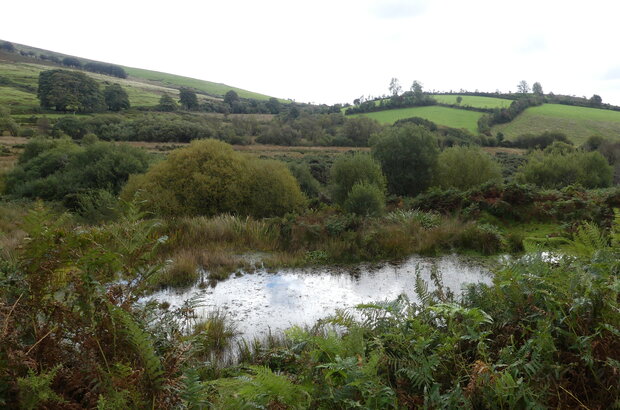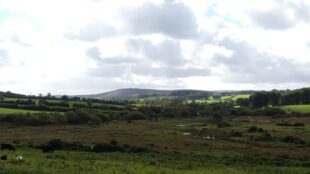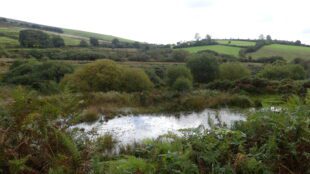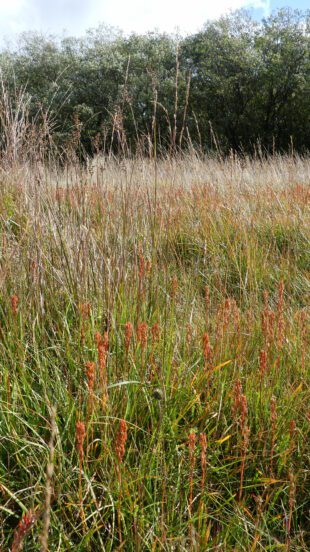
Earlier this year, my colleague Michael Sturla explained the value of farm visits to us in Defra and how we adapted them during the pandemic by making them virtual. With restrictions easing and a plan in place to keep everyone safe, we have started to resume our in-person farm visits.
They are a useful way for us to understand the context in which farmers work and what’s important to them. In this post, I'd like to share what I learned during a recent visit to Challacombe Farm on Dartmoor.
Farm Facts
Farm: Challacombe Farm, Postbridge, Dartmoor (tenant of the Duchy of Cornwall estate).
Size and type of farm: Organic. 180 hectares upland farm with 30 cattle plus 100 rare breed sheep.
Farmed by: Naomi Oakley and Mark Owen
Main enterprises: Grass fed beef and lamb. They diversify by hosting educational visits, selling rare breed sheep skins, honey and organic produce including wildflower seeds. They also offer piglet boarding (They take in piglets bred locally and rear them on behalf of the owners for a small fee. Once the pigs are ready for slaughter the owner collects them knowing their pigs have had a free-range life on farm.)
My role
I’m a senior policy adviser in the Future Farming Common Agricultural Policy (CAP) and Transition team. We are responsible for managing Environmental and Countryside Stewardship agreements under the European Union. We are also helping to develop and deliver the new environmental land management schemes.
At the moment, I am working on a new round of the Countryside Stewardship facilitation fund which is due to launch in December. This will include, for the first time, funding for groups that have beavers in their area. I am also working on the review of Countryside Stewardship payment rates – we’ll be publishing more information about that later this year.
Finally, I'm also working with Local Nature Recovery colleagues on a future collaboration offer.
Our visit
On 5 October members of my team visited Challacombe Farm on Dartmoor. The farm is run by Naomi Oakley and Mark Owen.
I had previously visited the farm with colleagues from the Rural Payments Agency. In my free time I love visiting the area for the beautiful landscape.
I think it's important that colleagues see, first hand, what our work funding environmental improvements can achieve. I also wanted them to meet Naomi and Mark, who are truly inspirational farmers.
Their approach: that you enhance and improve through organic methods, that you work with nature, that you put your animals first and that you positively encourage the public to explore the land – is one I wanted to share with colleagues.
The farm is an upland farm with significant archaeological features that need careful management. It is a mixed grazing system where the cattle are exclusively grass fed and the lambs are kept on farm until 18 months old.
The farm has numerous diversification interests including selling fleeces to a local business that makes felt coffins, honey sold on the farm, raising piglets for their owners before they are sent to market and selling grass seed and hay from their native flower meadows to local farmers.
Managing the transition: what Naomi and Mike showed us
Naomi and Mark’s farm is a good example of how environmental payments can indirectly fund important things for the landscape.
Challacombe is in a Higher Level Stewardship agreement. It includes environmentally-sensitive land, including Rhôs pastures (these are enclosed species-rich purple moor-grass and rush pastures. On Dartmoor, they are found in valley systems away from the open moor, usually in a mosaic with wet woodland, other species-rich grasslands and oakwood). It is also home to acres of wild bluebells and heathers which cover much of the valley in June.
Their Higher Level Stewardship payments indirectly fund the continued presence of a 19-year-old cow who leads the herd. The cow, in effect, manages the behaviour of the herd. She instinctively moves the herd around so they don’t over-graze one area. If the HLS scheme wasn't in place, the cow wouldn’t earn its place in the herd because she’s no longer breeding or being productive.
By avoiding over-grazing, they secure micro-environmental benefits through better grassland management and reduced negative impact of the herd on the land. This is one of the ways that the farmers use nature to their benefit without it costing them money.
They also showed how we could fund things differently for better environmental actions. To protect water quality, they agreed to install a silt trap to filter streams coming off the moor with silt and animal waste in them. Instead of a concrete filtration system (which we fund in our schemes), they devised and installed their own natural system, working with the natural topography of the land.
As a bonus, they secured a new freshwater pond for their cattle to drink from. In the last year they used Lidar data to map the soil levels on an area of previously-drained bog.
Using this data, they created new scrapes. Scrapes are shallow depressions with sloping edges, which seasonally hold water. They create obvious in-field ponds that are very attractive to wildlife. Ponds store and release water slowly, improving the natural flood management of the land. I would like to see this sort of practice encouraged through our schemes.
We discussed the Countryside Stewardship facilitation fund. Naomi and Mark are members of the local Dartmoor facilitation group. This scheme funded facilitators to bring farmers, foresters and land managers together for training and advice. It also co-ordinated environmental actions, the idea being that you get better outcomes through collaboration than acting alone.
Naomi found working with others inspiring and had a hand in their group plan for improving the habitat of the highly protected Marsh Fritillary and other butterflies.
They also learned that grazing their cattle in summer away from the riverbed would allow native salmon to spawn on their land. The number of salmon has increased downstream because their eggs have not been disturbed by cattle in search of cooling water. Instead, the cattle now graze on the hill where the summer winds prevail which keeps them cool naturally.
The valley is home to several birds that are either nationally scarce, such as Ring Ouzels and Hen Harriers, - or locally rare like the cuckoos who fly in from South Africa every year to predate on the Meadow Pipits who breed amongst the gorse and heather. Their sensitive landscape and forestry management in tandem with the British Trust for Ornithology (BTO) has created an area which has become well-known for its birds.
It was wonderful to see how this farm and its tenants, like many across the country. are already doing so much to safeguard their livestock and land. Additionally, that outcomes from environmental agreements can go beyond our policy intention.
If you have any questions about our farm visits or my work, do leave a comment below.
Pictures from the farm
- Improved grassland
- Re-wetted bogland
- Wildlife pond
- Rhos pasture
- Silt trap










 The
The 
14 comments
Comment by Jacqueline McCann-Lewis posted on
Wow Sarah! Reading your blog I felt I was out there with you and living in the South West it was a farm visit that I would have liked to have gone on, but wasn't free on that date. Naomi and Mark sound truly inspirational and I agree with you, there is a lot that others could learn form them and so great that they are already sharing their best practice. Thank you for the blog.
Comment by Sarah Blatchford posted on
Jacqueline- and anyone else in Defra who might be interested. Naomi has agreed to host another visit, hopefully in June next year when the valley is full of bluebells and Cuckoos. Please contact me if you would like to be added to an advance list of attendees. Otherwise more details and a chance to join the visit nearer the time.
Thank you for your lovely comment. It was a place I visited a lot in my imagination when we weren't allowed to travel as we liked last year. And when we were allowed to travel it was the first place I visited. I am glad the blog conveys how inspirational Naomi, Mark and the land they manage is.
Comment by Jacqueline McCann-Lewis posted on
Hi Sarah, yes please do count me in on the visit next year. Best wishes,
Comment by Simon S posted on
Very impressed by your blog Sarah and the work of Naomi and Mark. So glad to see the diverse and many ways in which Defra are approaching the transition period, which gives hope for the future of farming in the UK. Like the previous respondent the blog is inspirational and we’d like to find out more. Thank you for an interesting and quite moving article - I’m glad that Defra and RPA have you and, hopefully, others like you advising them.
Comment by Sarah Blatchford posted on
Thank you for your kind comments. Seeing farms like Challacombe which are delivering on our environmental schemes are the continued inspiration for what I do.
Comment by Steve Peel posted on
Naomi is doing great things here - is she still working full-time for Natural England?
Comment by Clare Pinches posted on
Hi Steve, Bit of a belated response but noticed you hadn't received a reply on here. Anyway yes Naomi still works for Natural England. It was actually , Justin Gillett who you may also recall as an excellent and very experienced advisor who worked with Naomi and husband Mark to develop an excellent agreement which delivers brilliant things for both nature and the farm.
Comment by jo stover posted on
Naomi and Mark sound like lovely people doing their best to farm in a sustainable way. But what about the bottom line? What is their profit/loss? How much food are they producing to fed our nation? Can all our farmers survive and produce food by following the example? I am a farmer committed to sustainability. My livestock is 100% grass fed. But I am a realist. If Defra doesn't support our farms, if subsidies are cut and monies go to wildlife and wood trusts we will not fed ourselves. We will import meat and export climate change. Our lovely countryside won't produce food. My grazing fields of permanent grassland are sequestering carbon but Defra won't pay me unless I plant woodlands. It 's all insane.
Comment by Sarah Blatchford posted on
Hello,
Thank you for your comment and interest. Challacombe sells the meat from their animals direct to the public. That produce is more expensive than supermarket fare but the demand is sufficient enough to mean the farm, on current predictions, will continue make a profit when subsidies end. There is a market for local produce reared in a high welfare setting which is sold directly to the public. Diversification is part of the story but part of the success of the farm comes from reviewing current practices and trialling different approaches to see what works alongside a high quality product. For me, part of the attraction of buying produce from the farm is knowing that, as a consumer, I am supporting the landscape I enjoy.
At the moment, the government is considering the evidence of Henry Dimbleby’s Independent Review of the Food System as it develops the forthcoming Food Strategy. In the programme, we will carefully consider the implications of the National Food Strategy for the management of rural land in the development of our new schemes.
At the heart of all this work, and something we totally share your view on, is our desire for a food system that supports people, nature and climate. We want to do all we can to ensure our farmers to continue to produce the high-quality, high-welfare produce for which they are renowned and - as you say - to be profitable. Our policy teams are working with farmers as we consider the relationship between food production and the environment. We believe that farming efficiently and protecting and enhancing the environment can go hand in hand, there does not have to be a trade-off.
Best wishes,
Sarah
Comment by Andrew Gardiner posted on
Sarah, cheers for sharing this with me. It sounds as if Naomi and Mark have embraced nature and have it working for them. Being able to retain the 19 year old cow who leads the herd really struck a chord with me, and perhaps harks to the way things were intended to be 'naturally'. Hearing that Facilitation Fund has helped inspirational farmers like Naomi and Mark shows the value of the scheme.
Comment by Sarah Blatchford posted on
Thank you for your interest. A lot of farmers and facilitators are working together to improve their local environment through these groups. I think that collaboration allows people to make a difference to their locality and to see what their neighbours are doing that works- and what doesn't work. I was really pleased to see that the facilitation group had a Marsh Frittillary strategy- seeds from the Devil's-bit-Scabious which grows at Challacombe is collected and shared with landowners in the group who have a suitable habitat for the plant. This extends the range of feeding area for the butterfly and encourages it's survival in the area.
Comment by Payne posted on
Let's hope many more people can do this kind of thing.Its good for every one in the end Let's see this done everywhere.Good luck to any one who can.
Comment by Sarah Blatchford posted on
Thank you for taking the time to read this blog. I agree it would be good if people are inspired or encouraged by farms like Challacombe to make their own changes.
Comment by Denise Seely posted on
I wonder if there is a list of facilitators in Northumberland? Must the participants farm land be contiguous or can it be say 20 miles away? My farm is 75 hec and has been under CS HT schemes for many years.